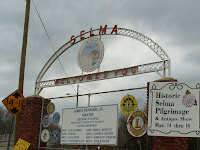On to Selma

We were on our way to Newbern, AL, where we wanted to check out the work of the Rural Studio. From Albany we headed up Hwy 82 to Montgomery, AL. Selma wasn't an intentional choice for a stop on our return trip from GA to CO, but Selma holds a significant place in civil rights history from the '60s. I first started looking for the bridge when we reached Montgomery. The highway is marked as a historic trail for the march from Selma to Montgomery that took place in March of 1965. The bridge is actually on the Selma side, where the march began. As we neared the city limits of Selma, we noticed a sign for a memorial park and stopped to read the brass markers and see what was there.




The markers honor leaders including Hosea Williams, John Lewis, Amelia Boynton and Marie Foster. Near these formal markers is an impressive pile of rock. These 12 stones reflect the message from Josh. 4:21-22: "When your children shall ask you in time to come saying what mean these 12 stones then you shall tell them how you made it over." The martyrs stone is inscribed to remember the nine (from north and south, both black and white) who lost their lives in the violent time of struggle to obtain equal rights for all citizens. A mural is painted on the side of a dilapidated night club next to the park. The faces are of martyrs for the cause, white and black. It is garish, primitive, and unsettling. After crossing the Edmund Pettus bridge (kind of creepy) we began to look at the downtown buildings of Selma. The town doesn't show much change from how it must have looked 40 years ago. If there is affluence it's not evident. On an old paint-peeling storefront there is a sign for the voting rights museum. We pulled into a parking place across the street from it. Only a few people were inside the dark cramped entrance where a desk took up one side. A small number of framed items on the wall, a stack of Foot Soldier newspapers and narrow hallway were what greeted us, in addition to the young woman sitting at the desk. We decided not to tour the rest of the museum since she told us it would take 30-45 minutes, but we did talk with her a few minutes and I took a newspaper since there were no brochures or other information available. We had arrived 2 days too late. The festival commemorating Bloody Sunday and the march to Montgomery had happened over the weekend. There were some famous names scheduled to speak, but no presidential candidates came this year. I hope to join in the symbolic memorial march when I can.


An interesting thing we found out about is a museum connected to the man who was mayor when police beat civil rights demonstrators at the Edmund Pettus Bridge in March 1965. Joe Smitherman was a segregationist, but now says he was "on the wrong side of history". Amazingly, he was in office for 36 years! In 2000, James Perkins, Selma's first black mayor was elected. Smitherman was hoping to be re-elected so that whites would be represented in this majority black town. He believed there needed to be diversity. As far as I know the segregationist museum is still in operation even though Mayor Smitherman is not.
There were three marches in Selma, essentially about voting rights. Within five months of the third march, President Lyndon Johnson signed the Voting Rights Act of 1965.
My civil rights tour will continue to be interspersed with other blog posts until I feel it is done...




0 Comments:
Post a Comment
<< Home